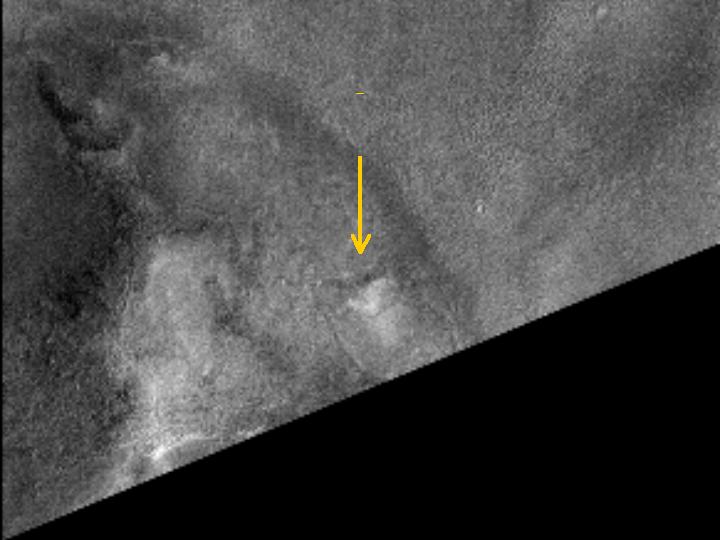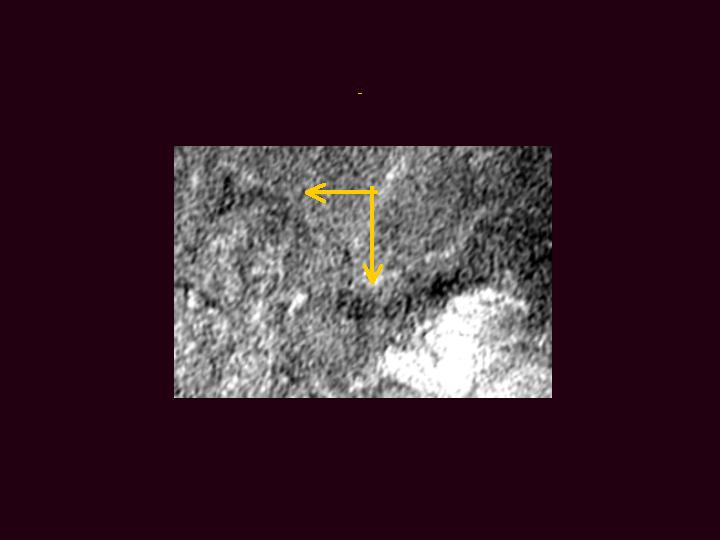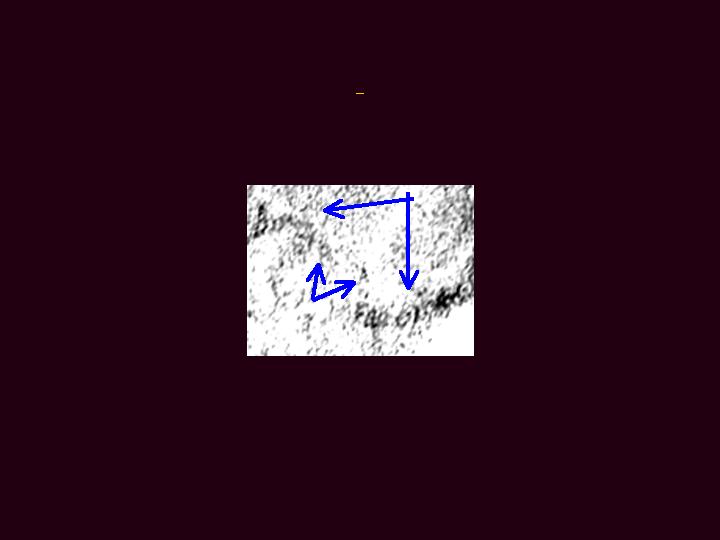The 'Symbols' on Mars
by Tom Van Flandern 01/05/01
[Editor's note: This article comments on apparent symbols in MGS images of the surface of Mars. For context the slides discussed here were as part of a series of images in the slide presentation 'Artificial Structures on Mars' 01/04/05.]
One of the features seen by MGS at Cydonia is so unusual as to justify separate commentary by itself. Indeed, it has been a subject of intense and heated debate since the day of its discovery by SPSR geologist Harry Moore a few days after the first MGS image of Cydonia became available in early April 1998. If these strange markings on the surface of Mars are what they appear to some to be - symbols reminiscent of certain terrestrial alphabets - then they would represent a form of communication from intelligent beings. By comparison, questions of artificial versus natural origin for the Face pale in significance. If that conclusion is to be avoided, the possibilities seem limited - either the markings are on Mars, but resemble symbols only by chance; or the markings are not on Mars, and were introduced into the image somewhere along the line, either by accident or by design. Let’s examine each possibility.
Presentation Figure 50 shows the region of the dark surface markings on Mars, from the 1998 April 5 MGS image, just above a “V”-shaped bright albedo feature close to the bottom center of the strip. Presentation Figure 51 shows a close-up of the main symbols. Presentation Figure 52 shows a similar view with a noise-suppression filter active. The noise filter is not required by any means. In fact, its value was discovered quite by chance more than a year after Moore’s original finding, when an image of the markings was viewed on the preview screen of a video camera that had noise suppression operative to emphasize the important objects in the field of view by making the background flat and uniform. After they know what they are looking for and where to look, many people have remarked that these surface markings “jump off the page” when viewed on the original, unfiltered image, as in Figure 50.
Can they be accidental? The key point here is that they are not simply shapes seen in a noisy background, but rather shapes that stand out distinctively from that background. They are darker than anything in their immediate vicinity. In Figure 52, we see possibly as many as four large “symbols” [“B”, “P”, “A”, and “F”]. The larger ones seem to appear alone or at the left end (taking the Face orientation as defining upright) of linear strings of smaller symbols, many of them unrecognizable. But the pattern is reminiscent of words beginning with capital letters. And these are not the only occurrences of letter-like markings in the Cydonia area. Where others occur, they too look “deliberate” rather than accidental, even though not all of the markings form recognizable letters of the main terrestrial alphabets. But they have in common that they are composed of simple lines and curves, as non-pictographic terrestrial alphabets tend to be.
Other examples are available. One of these shows some resemblance to Arabic numerals. These raise the question, at least in this author’s mind, whether our modern alphabets and numerals might perhaps be far older than has been reasonable to assume up to now. It is not obvious at my distance from the field of the history of alphabets and numerals that any hard evidence of their origin in recent pre-history exists, as opposed to simply invoking that as a reasonable working assumption. One sample of possible lettering appears on the outside rim of a crater, surely an odd site for such a phenomenon to arise by chance. Not all the alphabet-like markings resemble Roman letters, nor can they be identified with any alphabet existing in modern times, to my knowledge. Yet these markings give the impression of deliberateness, not simply non-random patterns seen in random noise.
One obvious objection involves the same a priori principle that we invoked to argue for artificiality elsewhere - we cannot know the significance of an unpredicted shape or set of shapes upon first seeing. It follows that the existence of these dark surface markings resembling symbols cannot be used as independent evidence for the artificiality of Cydonia. However, given such evidence nearby - specifically, given the artificiality of the Face based on unrelated evidence - the matter has a different character. It is then more reasonable that these markings are symbols and are the products of intelligent beings than that they arose by chance. We therefore conclude that, if on Mars, the markings are indeed symbols.
But could the markings have been introduced into the image somewhere along the path from spacecraft image acquisition at Mars to posting on the Internet, where the data resides today for anyone to download from the JPL/NASA site and see these features for themselves? Let us leave aside the question of motive for any deliberate introduction (e.g., a hoax). The original images remain to this day under control of U.S. Government contractors. So the severe penalties for destruction of government property (likely to be more severe than being fired) and the apparently opposite motives of the parties with access to the data argue against the hoax hypothesis. However, ultimately, the motive of a potential hoaxer must be considered unknown. So we confine the remainder of the discussion to the question of access - who had it and when? Because this question has arisen, it is in hindsight a fortunate circumstance for our purposes here that accusations had arisen in the tabloid media about NASA and/or JPL and/or Malin Space Sciences Systems (MSSS) being involved in a conspiracy to hide the truth about artifacts on Mars To ensure in a reasonable way that no such manipulation was taking place, reporters were present at MSSS when the data was first downloaded to local computers, and the process of converting the image from spacecraft format to Internet format and posting the image to the Internet was witnessed by these outside observers. Because this format conversion process took place entirely within the local computers in a time span of about 20 minutes, and because the process cannot itself alter the image in any manner that is important to the symbols issue, the possibility of an accidental introduction of “writing” seems excluded. That would require, at a minimum, that the image was processed by human hands at some stage, but no such step occurred. And it could not have happened after posting to the Internet because thousands of interested parties, including this author, downloaded the raw image from the Internet within minutes of its posting there. The symbols are present in the raw data, and have been from its first appearance on the Internet.
Only the question of a deliberate introduction remains unexamined. However, this would require a specialized computer program of the most sophisticated type. The larger symbols, when examined in detail with high magnification, are seen to be 12 pixels tall, and those individual pixels are well integrated into the image, not simply substituted or superimposed. For example, visualize a bright-dark border at some angle in an image. Individual pixels showing the border will not generally be all bright or all dark, but will consist of varying mixtures of bright and dark because the border pixel will generally overlap a bit of each side. And that is exactly what we find with the borders of the symbols in this Cydonia image. In other words, all the individual pixels along the border of symbols share in the background, unlike what would occur if they were superimposed onto an existing image.
Moreover, such a hypothetical sophisticated computer program to falsify images would not have known in advance what range of grayscales (a total of 35 out of a possible 256) would be utilized in the image because this information would depend on the time of day, degree of cloudiness or atmospheric transparency, and other unpredictable factors. It would not have known what features were in the image because the spacecraft pointing accuracy is not great enough to locate any particular feature in a precise portion of a high-resolution image. And in general, the program would not have known in advance how to locate and integrate the symbols into the background without making it obvious they were superimposed.
Making a program smart enough to anticipate all reasonable contingencies and sophisticated enough to avoid hints of its forged character would probably require a concerted effort of some of the world’s best image processing experts and months of labor. Who would undertake and fund such a fraud? I suggest that such a vast conspiracy of experts would call into question every bit of data yet collected by our space program. Indeed, even the question of whether or not the entire space program has been a hoax would have to be examined. (That question has been raised elsewhere, but not with what generally passes for “credible evidence”.) Therefore, while the probability of such happenings is certainly far greater than the probability of the secondary facial features of the Cydonia Face arising by chance, it is nonetheless small enough to be neglected in the absence of some other hard evidence (as distinct from the ever-present suspicions of the conspiracy-minded among us) of an actual conspiracy.
This leaves us with the conclusion that the symbols are on Mars as the most reasonable possibility. Yet it seems the symbols are unlikely to be accidents of nature, and are most probably artificial in view of their proximity to the Face. The logical consequences of this will of course not follow if any of these arguments is invalid. But because alternative possibilities seem comfortably remote, we are inclined to proceed with drawing logical consequences of artificial, alphabet-like symbols on Mars. I acknowledge that readers not yet ready to accept all the premises and conclusions that brought us to this point will certainly not accept what follows from them. On the other hand, a dislike of the implications, whatever they may be, is not in general a valid reason for doubting the premises and conclusions that brought us to this point. In the words of Steven Goldberg, “The consequences of a claim that something is true are entirely irrelevant to the issue of whether the claim is true.”



